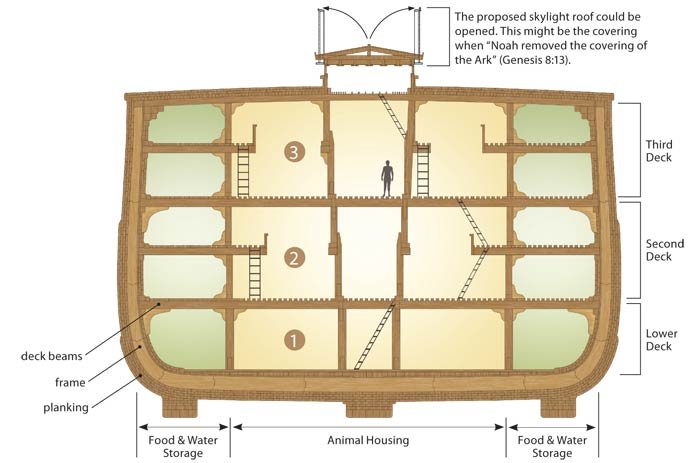 |
| Ark Encounter- Wikimedia (Jameywiki) |
...enabling Christians to defend their faith and to proclaim the gospel of Jesus Christ effectively. We focus particularly on providing answers to questions surrounding the book of Genesis, as it is the most-attacked book of the Bible.(Link)A recent article by Carmine Grimaldi published on the website of the Atlantic (The Obsession with Biblical Literalism) explores the difficulties of the approach to scripture which underlies the project. Grimaldi emphasizes the fact that the builders provide information lacking in the Bible, filling in gaps. The Ark Encounter engages its visitors with a great deal of additional non-biblical details, such as the names and personalities of the women, and hobbies and games to pass the time during the long stay on board the ark. Grimaldi writes, "For self-proclaimed literalists, the ark includes a striking amount of fabrications and fictionalizations."
Sure. But both Jews and Christians have a long history of developing traditional names and information about people and incidents in the Bible. Filling in the gaps is a necessary interpretive move in any context, but especially when details are sparse. The account of Noah, typical of many biblical narratives, is not concerned with providing details such as the name of the women, or the quality of the living quarters aboard the ark.
 |
| AiG- Caring for Animals on the Ark |
 |
| AiG- Caring for Animals on the Ark |
What I find more compelling in Grimaldi's article is the effort AiG puts into emphasizing the feasibility of the flood narrative. On its website, AiG offers schematics, analyses of food and waste management (gutters, methane vents, sloped cage floors, etc.) as well as suggestions for piping and fresh water tanks. A commitment to young earth creationism creates further problems, as the dinosaurs must be accounted for as well. "In Genesis 6:19–20, the Bible says that two of every sort of land vertebrate (seven of the “clean” animals) were brought by God to the Ark. Therefore, dinosaurs, (land vertebrates) were represented on the Ark." AiG asserts that this challenge is overcome by careful reading. The Bible says that two of every "kind" of animal was on the ark. In the case of a cat, for example, that does not mean two jaguars, two lions, two short-haired domestics, etc. Rather, a single pair of cats, perhaps "similar to proilurus, an extinct cat of Asia and Europe" could have been on the ark and given rise to the many dozens of feline species we now know. The same could be said for the dinosaurs (approximately 55 "kinds") and every other creature. (Link)
 |
| AiG- Reimagining Ark Animals |
This emphasis on feasibility is also used to present the biblical account of the flood as superior to those found in other ancient traditions. Grimaldi writes that "visitors can watch animated simulations of ships from other diluvial myths being tossed in rough water. They all sink, often to the sound of terrified screams." The PBS program NOVA seems to be interested in this game as well, as they recently aired an episode called "Secrets of Noah's Ark." It more properly should have been called the "Secret of Atrahasis' Ark," since it featured the rebuilding of the boat as described in the Sumerian flood narrative. Yet the NOVA experiment was essentially the same, wondering if the tablet was "nothing more than a fanciful myth? Or could such a reed boat have carried Atra-Hasis’ family of more than one hundred and his many animals?"
This emphasis on feasibility reminds me of an earlier tradition in biblical reception, which was founded on an Enlightenment-era rejection of the miraculous. The a priori rejection of anything that might violate the laws of nature, which were rapidly being refined and understood, led to mental gymnastics to explain how the events recorded in the Bible could be historically accurate, yet not miraculous. Red algae blooms in the Nile and severe wind storms help to explain the early chapters of Exodus, while people inspired by Jesus' teaching to share their bread and fish with others explains the gospels' miraculous feedings. (William Lane Craig provides an excellent overview of "The Problem of Miracles.")
I agree with Grimaldi's conclusion that biblical literalism is hampered by the necessary filling of textual gaps, but I think AiG's greater challenge is being in the position of hypothesizing difficult scientific solutions for the non-miraculous in order to defend the existence of the miraculous.
Isaac M. Alderman
Follow me on Twitter @isaacalderman
Follow Bible Junkies on Twitter @Biblejunkies
Feel free to“Like” Biblejunkies on Facebook
0 comments:
Post a Comment